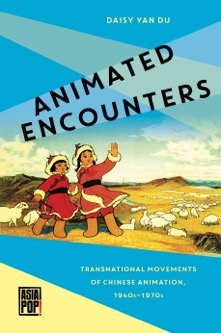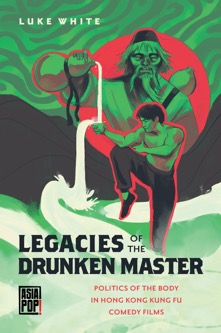Asia Pop!
Given my own personal and scholarly interests in popular culture, it is my pleasure to serve as the editor of Asia Pop! book series at the University of Hawai'i Press. Created in partnership with Stephanie Chun, UHP acquisitions editor, the series includes cutting edge scholarship that engages popular culture across time and space.

The series is dedicated to analyzing Asian popular cultures and does so across historical periods, within local and global contexts, and from multiple disciplinary traditions. We welcome innovative approaches to analyzing a variety of media products and productions—from cell phone novels to eSports and video games, from art toys to idol groups. Submissions are encouraged from a range of disciplines, including anthropology, film studies, gender studies, history, information and media studies, literature, queer studies, and sociology. Translations of key texts relevant to the series’ central themes are also welcome.
Animated Encounters: Transnational Movements of Chinese Animation, 1940s–1970s
Daisy Yan Du
China’s role in the history of world animation has been trivialized or largely forgotten. In Animated Encounters Daisy Yan Du addresses this omission in her study of Chinese animation and its engagement with international forces during its formative period, the 1940s–1970s. She introduces readers to transnational movements in early Chinese animation, tracing the involvement of Japanese, Soviet, American, Taiwanese, and China’s ethnic minorities, at socio-historical or representational levels, in animated filmmaking in China. Du argues that Chinese animation was international almost from its inception and that such border-crossing exchanges helped make it “Chinese” and subsequently transform the history of world animation. She highlights animated encounters and entanglements to provide an alternative to current studies of the subject characterized by a preoccupation with essentialist ideas of “Chineseness” and further questions the long-held belief that the forty-year-period in question was a time of cultural isolationism for China due to constant wars and revolutions.
China’s socialist era, known for the pervasiveness of its political propaganda and suppression of the arts, unexpectedly witnessed a golden age of animation. Socialist collectivism, reinforced by totalitarian politics and centralized state control, allowed Chinese animation to prosper and flourish artistically. In addition, the double marginality of animation—a minor art form for children—coupled with its disarming qualities and intrinsic malleability and mobility, granted animators and producers the double power to play with politics and transgress ideological and geographical borders while surviving censorship, both at home and abroad.
A captivating and enlightening history, Animated Encounters will attract scholars and students of world film and animation studies, children’s culture, and modern Chinese history.
Pop Empires: Translational and Diasporic Flows of India and Korea
Edited by S. Heijin Lee, Monika Mehta, and Robert Ji-Song Ku
At the start of the twenty-first century challenges to the global hegemony of U.S. culture are more apparent than ever. Two of the contenders vying for the hearts, minds, bandwidths, and pocketbooks of the world’s consumers of culture (principally, popular culture) are India and South Korea. “Bollywood” and “Hallyu” are increasingly competing with “Hollywood”—either replacing it or filling a void in places where it never held sway.
This critical multidisciplinary anthology places the mediascapes of India (the site of Bollywood), South Korea (fountainhead of Hallyu, aka the Korean Wave), and the United States (the site of Hollywood) in comparative dialogue to explore the transnational flows of technology, capital, and labor. It asks what sorts of political and economic shifts have occurred to make India and South Korea important alternative nodes of techno-cultural production, consumption, and contestation. By adopting comparative perspectives and mobile methodologies and linking popular culture to the industries that produce it as well as the industries it supports, Pop Empires connects films, music, television serials, stardom, and fandom to nation-building, diasporic identity formation, and transnational capital and labor. Additionally, via the juxtaposition of Bollywood and Hallyu, as not only synecdoches of national affiliation but also discursive case studies, the contributors examine how popular culture intersects with race, gender, and empire in relation to the global movement of peoples, goods, and ideas.
Puppets, Gods, and Brands: Theorizing the Age of Animation from Taiwan
Teri Silvio
The early twenty-first century has seen an explosion of animation. Cartoon characters are everywhere—in cinema, television, and video games and as brand logos. There are new technological objects that seem to have lives of their own—from Facebook algorithms that suggest products for us to buy to robots that respond to human facial expressions. The ubiquity of animation is not a trivial side-effect of the development of digital technologies and the globalization of media markets. Rather, it points to a paradigm shift. In the last century, performance became a key term in academic and popular discourse: The idea that we construct identities through our gestures and speech proved extremely useful for thinking about many aspects of social life. The present volume proposes an anthropological concept of animation as a contrast and complement to performance: The idea that we construct social others by projecting parts of ourselves out into the world might prove useful for thinking about such topics as climate crisis, corporate branding, and social media. Like performance, animation can serve as a platform for comparisons of different cultures and historical eras.
Teri Silvio presents an anthropology of animation through a detailed ethnographic account of how characters, objects, and abstract concepts are invested with lives, personalities, and powers—and how people interact with them—in contemporary Taiwan. The practices analyzed include the worship of wooden statues of Buddhist and Daoist deities and the recent craze for cute vinyl versions of these deities, as well as a wildly popular video fantasy series performed by puppets. She reveals that animation is, like performance, a concept that works differently in different contexts, and that animation practices are deeply informed by local traditions of thinking about the relationships between body and soul, spiritual power and the material world. The case of Taiwan, where Chinese traditions merge with Japanese and American popular culture, uncovers alternatives to seeing animation as either an expression of animism or as “playing God.” Looking at the contemporary world through the lens of animation will help us rethink relationships between global and local, identity and otherness, human and non-human.
Legacies of the Drunken Master: Politics of the Body in Hong Kong Kung Fu Comedy Films
Luke White
In 1978 the films Snake in the Eagle’s Shadow and Drunken Master, both starring a young Jackie Chan, caused a stir in the Hong Kong cinema industry and changed the landscape of martial arts cinema. Mixing virtuoso displays of acrobatic kung fu with knockabout humor to huge box office success, they broke the mold of the tragic and heroic martial arts film and sparked not only a wave of imitations, but also a much longer trend for kung fu comedies that continues to the present day.
Legacies of the Drunken Master—the first book-length analysis of kung fu comedy—interrogates the politics of the films and their representations of the performing body. It draws on an interdisciplinary engagement with popular culture and an interrogation of the critical literature on Hong Kong and martial arts cinema to offer original readings of key films. These readings pursue the genre in terms of its carnival aesthetic, the utopias of the body it envisions, its highly stylized depictions of violence, its images of masculinity, and the registers of its “hysterical” laughter.
The book’s analyses are carried out amidst kung fu comedy’s shifting historical contexts, including the aftermath of the 1960s radical youth movements, the rapidly globalizing colonial enclave of Hong Kong and the emerging consciousness of its 1997 handover to China, and the transnationalization of cinema audiences. It argues that through kung fu comedy’s images of the body, the genre articulated in complex and often contradictory ways political realities relevant to late twentieth-century Hong Kong and the wider conditions of globalized capitalism. The kung fu comedy entwines us in a popular cultural history that stretches into the folk past and forward into utopian and dystopian possibilities.
Theoretically rich and critical, Legacies of the Drunken Master aims to be at the forefront of scholarship on martial arts cinema. It also addresses readers with a broader interest in Hong Kong culture and politics during the 1970s and 1980s, postcolonialism in East Asia, and action and comedy films in a global context—as well as those fascinated with the performing body in the martial arts.

Edited by James Welker
The boys love (BL) genre was created for girls and women by young female manga (comic) artists in early 1970s Japan to challenge oppressive gender and sexual norms. Over the years, BL has seen almost irrepressible growth in popularity and since the 2000s has become a global media phenomenon, weaving its way into anime, prose fiction, live-action dramas, video games, audio dramas, and fan works. BL’s male–male romantic and sexual relationships have found a particularly receptive home in other parts of Asia, where strong local fan communities and locally produced BL works have garnered a following throughout the region, taking on new meanings and engendering widespread cultural effects.
Queer Transfigurations is the first detailed examination of the BL media explosion across Asia. The book brings together twenty-one scholars exploring BL media, its fans, and its sociocultural impacts in a dozen countries in East, Southeast, and South Asia—and beyond. Contributors draw on their expertise in an array of disciplines and fields, including anthropology, fan studies, gender and sexuality studies, history, literature, media studies, political science, and sociology to shed light on BL media and its fandoms.
Queer Transfigurations reveals the far-reaching influences of the BL genre, demonstrating that it is truly transnational and transcultural in diverse cultural contexts. It has also helped bring about positive changes in the status of LGBT(Q) people and communities as well as enlighten local understandings of gender and sexuality throughout Asia. In short, Queer Transfigurations shows that, some fifty years after the first BL manga appeared in print, the genre is continuing to reverberate and transform lives.



